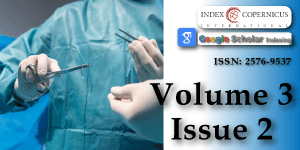ROGAVF STUDY 2019 - Relationship of HbA1C (GLYCEMIC Control) on outcomes of AV FISTULAS: A prospective observational study
Main Article Content
Abstract
Objective: The main aim of the study was to compare outcomes based on diabetic control for patients undergoing formation of a new upper limb arteriovenous fistula (AVF). Research design and methods: A prospective cohort study was performed where we obtained baseline HbA1c in 65 patients before undergoing AV fistula formation. Patients were followed up at our clinic 6 weeks after creation to assess fistula maturity.
Results: Multiple logistic regression was used to analyze the association between HbA1c status and maturity of AVF at 6 weeks after controlling for possible confounding factors such as age, sex, presence of hypertension and dyslipidaemia. Those with HbA1c less than 6.5 were 22 times likely to have maturity of AVF at 6 weeks as compared to those with HbA1c 6.5 or more (AOR = 22.65, p < 0.005)
Conclusion: Good diabetes control, reflected by an HbA1c of less than 6.5, is associated with a very high possibility of AVF maturity at 6 weeks post creation.
Article Details
Copyright (c) 2019 Singh P, et al.

This work is licensed under a Creative Commons Attribution 4.0 International License.
Shaw JE, Sicree RA, Zimmet PZ. Global estimates of the prevalence of diabetes for 2010 and 2030. Diabetes Res Clin Pract. 2010; 87: 4-14. PubMed: https://www.ncbi.nlm.nih.gov/pubmed/19896746
Fluck R, Kumwenda M. UK Renal Association Clinical Practice Guidelines on vascular access for haemodialysis. Nephron Clin Pract. 2011; 118: c225-240. PubMed: https://www.ncbi.nlm.nih.gov/pubmed/21555898
Malovrh M. Native arteriovenous fistula: preoperative evaluation. Am J Kidney Dis. 2002; 39: 1218-1225. PubMed: https://www.ncbi.nlm.nih.gov/pubmed/12046034
Rinsho Byori. Indicators of glycemic control --hemoglobin A1c (HbA1c), glycated albumin (GA), and 1,5-anhydroglucitol (1,5-AG). Rinsho Byori. 2014; 62: 45-52. PubMed: https://www.ncbi.nlm.nih.gov/pubmed/24724426
Gordon AC. Diabetes should not disuade aretriovenous fistula formation. British Journal of Diabetes. 2016.
Mortaz, et al. AV Fistulas in Diabetics. Urology Journal. 2013; 10: 826-827.
Sesso R, Melaragno CS, Luconi PS. [Survival of dialyzed diabetic patients]. Rev Assoc Med Bras. 1995; 41: 178-8214.
Asif A, Roy-Chaudhury P, Beathard GA. Early arteriovenous fistula failure: a logical proposal for when and how to intervene. Clin J Am Soc Nephrol. 2006; 1: 332-339. PubMed: https://www.ncbi.nlm.nih.gov/pubmed/17699225
Tuka V, Slavikova M, Svobodova J, Malik J. Diabetes and distal access location are associated with higher wall shear rate in feeding artery of PTFE grafts. Nephrol Dial Transplant. 2006; 21: 2821-2824. PubMed: https://www.ncbi.nlm.nih.gov/pubmed/16735379
Miller PE, Tolwani A, Luscy CP, Deierhoi MH, Bailey R, et al. Predictors of adequacy of arteriovenous fistulas in hemodialysis patients. Kidney Int. 1999; 56: 275-280. PubMed: https://www.ncbi.nlm.nih.gov/pubmed/10411703
Wu CC, Wen SC, Yang CW, Pu SY, Tsai KC, et al. Baseline plasma glycemic profiles but not inflammatory biomarkers predict symptomatic restenosis after angioplasty of arteriovenous fistulas in patients with hemodialysis. Artherosclerosis. 2010; 209: 598-600. PubMed: https://www.ncbi.nlm.nih.gov/pubmed/19939386
Murphy GJ, Nicholson ML. Autogeneous elbow fistulas: the effect of diabetes mellitus on maturation, patency, and complication rates. Eur J Vasc Endovasc Surg. 2002; 23: 452-457. PubMed: https://www.ncbi.nlm.nih.gov/pubmed/12027475





